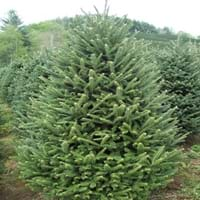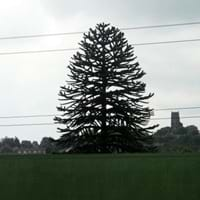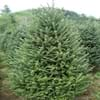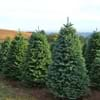Life Span
Perennial
Perennial
Type
Needled or Scaled Evergreen
Needled or Scaled Evergreen
Origin
Northeastern United States, Canada
Argentina, Chile
Types
Balsam fir, Fraser fir
not available
Number of Varieties
Not Available
Habitat
Hillside, Mountains, Rocky areas
Subtropical forests
USDA Hardiness Zone
3-6
7-11
Sunset Zone
A3, 1a, 1b, 2a, 2b, 3a, 3b, 4, 5, 6, 7, 15, 16, 17
H1, H2, 4, 5, 6, 7, 8, 9, 14, 15, 16, 17, 18, 19, 20, 21, 22, 23, 24
Habit
Pyramidal
Oval or Rounded
Minimum Width
Not Available
Flower Color
Not Available
Green
Flower Color Modifier
Bicolor
Bicolor
Leaf Color in Spring
Light Green, Dark Green
Green, Dark Green
Leaf Color in Summer
Dark Green
Dark Green
Leaf Color in Fall
Dark Green
Dark Green
Leaf Color in Winter
Dark Green
Dark Green
Leaf Shape
Needle like
Needle like
Plant Season
Spring, Summer, Fall, Winter
Spring, Summer, Fall, Winter
Sunlight
Full Sun, Partial Sun, Partial shade
Full Sun, Partial Sun
Type of Soil
Loam, Sand
Clay, Loam, Sand
The pH of Soil
Acidic, Neutral
Acidic, Neutral, Alkaline
Soil Drainage
Well drained
Well drained
Bloom Time
Not Available
Not Available
Tolerances
Drought
Drought
Where to Plant?
Container, Ground, Pot
Ground, Pot
How to Plant?
Seperation, Stem Planting, Transplanting
Tip cutting
Plant Maintenance
Medium
Medium
Watering Requirements
Average Water Needs, Never Over-water, Requires regular watering, Water when soil is dry
Allow to dry out slightly between watering
In Summer
Lots of watering
Lots of watering
In Spring
Moderate
Moderate
In Winter
Average Water
Average Water
Soil pH
Acidic, Neutral
Acidic, Neutral, Alkaline
Soil Type
Loam, Sand
Clay, Loam, Sand
Soil Drainage Capacity
Well drained
Well drained
Sun Exposure
Full Sun, Partial Sun, Partial shade
Full Sun, Partial Sun
Pruning
Prune if you want to improve plant shape, Remove branches, Remove damaged leaves, Remove dead leaves, Remove dead or diseased plant parts
Remove damaged leaves, Remove dead branches, Remove dead leaves
Fertilizers
All-Purpose Liquid Fertilizer
All-Purpose Liquid Fertilizer
Pests and Diseases
Red blotch
Anthracnose, Branch Droop, Root rot, Yellow Leaves
Plant Tolerance
Drought
Drought
Flowers
Insignificant
Insignificant
Flower Petal Number
Single
Single
Fragrant Bark/Stem
Yes
Yes
Foliage Texture
Fine
Fine
Foliage Sheen
Not Available
Glossy
Attracts
Flies, Insects, Spider Mites
Not Available
Allergy
Cold, Congestion, sneezing, wheezing
Not Available
Aesthetic Uses
Beautification, Landscape Designing, Showy Purposes, Used as Christmas tree
Showy Purposes, Used as Christmas tree
Beauty Benefits
Not Available
Not Available
Environmental Uses
Air purification
Air purification
Medicinal Uses
Stomach pain
Not Available
Part of Plant Used
Fruits, Leaves, Stem, Whole plant
Whole plant
Other Uses
Air freshner, Decoration Purposes, Showy Purposes, Used as Christmas Tree, Used as Ornamental plant, Used in Furniture, Wood is used for making furniture
Used in Furniture, Useful for shade
Used As Indoor Plant
Yes
Yes
Used As Outdoor Plant
Yes
Yes
Garden Design
Feature Plant, Screening, Wind Break
Container, Feature Plant
Botanical Name
ABIES balsamea phanerolepis
ARAUCARIA araucana
Common Name
Canaan Fir
Monkey Tail Tree, Chilean Pine, Pehuén
In Hindi
कनान प्राथमिकी
Monkey Puzzle Tree
In German
Canaan Fir
Chilenische Araukarie
In French
Canaan sapin
Araucaria du Chili
In Spanish
Canaán abeto
araucaria o pehuén
In Greek
Χαναάν Fir
Monkey Puzzle Tree
In Portuguese
Canaã Fir
Monkey Puzzle Tree
In Polish
Canaan Fir
Araukaria chilijska
In Latin
Canaan abies
Monkey Puzzle Tree
Phylum
Coniferophyta
Pinophyta
Class
Pinopsida
Pinopsida
Family
Pinaceae
Araucariaceae
Clade
Not Available
Not Available
Tribe
Not Available
Not Available
Subfamily
Not Available
Not Available
Number of Species
Not Available
Not Available
Importance of Canaan Fir and Monkey Puzzle Tree
Want to have the most appropriate plant for your garden? You might want to know the importance of Canaan Fir and Monkey Puzzle Tree. Basically, these two plants vary in many aspects. Compare Canaan Fir and Monkey Puzzle Tree as they differ in many characteristics such as their life, care, benefits, facts, etc. Every gardener must at least have the slightest clue about the plants he wants to plant in his garden. Compare their benefits, which differ in many ways like facts and uses. The medicinal use of Canaan Fir is Stomach pain whereas of Monkey Puzzle Tree is Not Available. Canaan Fir has beauty benefits as follows: Not Available while Monkey Puzzle Tree has beauty benefits as follows: Not Available.
Compare Facts of Canaan Fir vs Monkey Puzzle Tree
How to choose the best garden plant for your garden depending upon its facts? Here garden plant comparison will help you to solve this query. Compare the facts of Canaan Fir vs Monkey Puzzle Tree and know which one to choose. As garden plants have benefits and other uses, allergy is also a major drawback of plants for some people. Allergic reactions of Canaan Fir are Cold, Congestion, sneezing and wheezing whereas of Monkey Puzzle Tree have Not Available respectively. Having a fruit bearing plant in your garden can be a plus point of your garden. Canaan Fir has showy fruits and Monkey Puzzle Tree has showy fruits. Also Canaan Fir is not flowering and Monkey Puzzle Tree is not flowering . You can compare Canaan Fir and Monkey Puzzle Tree facts and facts of other plants too.





